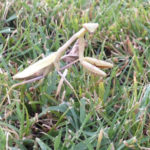5 tips for keeping the garden alive during a drought
| What? You garden doesn’t look like this mid-January? Mine either. Photo from May, 2013. Sigh. |
For the past month, my dreams have literally been coming true. The patios and boulders and shrubbies that have occupied my thoughts for the last several years? Well, they’re springing to life in our back yard. Right now!
So, you can imagine the nightmare that I’m finding the current California drought to be. Not only is the water supply in peril along with so many major industries–hello, my state produces much of the country’s produce!–but my beautiful veggie garden is already in jeopardy and I haven’t even planted it yet.
At this rate, water conservation is recommended in Sacramento where I live, but not mandated outside of normal procedures. However, unless we get some good rain, it won’t be too long before non-essential watering is temporarily banned. (It feels so strange to be writing about this when so much of the country is buried under snow right now.)
The good news? There are lots of ways to save water and keep the garden going. I’m going to be trying all of these tips here soon:
1. Literally save water. Grey water (i.e., water from showers, sinks, washing machines) can be collected and used for thirsty landscaping. Collection methods range from very fancy pipe/drum systems that funnel water from showers and laundry machines to plants (see here), to the highly sophisticated Shawna system that involves catching water in a 5-gallon bucket from Home Depot. Apparently you can use most water so long as it doesn’t contain feces (ick) or toxic chemicals. I’m starting to collect bath water, pasta water from the kitchen, and water used for light cleaning.
2. Mulch, mulch, mulch. Three to six inches of mulch will help keep plants from needing water as often. Bonus, it will also keep weeds away.
3. Ditch the terra cotta. Well really, use pots that don’t let moisture evaporate so quickly, such as glazed ceramic or plastic. Or considering sealing terra cotta, the porous clay enables soil to dry out significantly faster than sealed materials.
 |
| Dig all of those glazed pots! Another trick I’m using is to keep saucers under the pots to catch water run-off (unlike in this picture, ahem). |
4. Water deeply but less frequently. Best way to keep plants healthy? Get them to develop strong root systems. Best way to do that? Watering deeply as it encourages plants to send roots down to get the water instead of out near the surface of soil. Most garden plants need an inch or so of water every week, but it’s better to water deeply once a week rather than quickly three times a week. (Of course this depends on what you’re watering and whether it’s in-ground or in pots, but the principle remains!)
5. Supplement the soil. A good way to stretch the soil’s moisture? Amendments. Organic matter (compost, peat moss) will keep the soil healthy and enable it to retain more moisture. Minerals like vermiculite and perlite absorb water and expand, keeping soil moister longer (perlite = those little white bits in potting soil).
Or, you can experiment with baby diapers. Yes, I said baby diapers. My lovely mother-in-law, Mom-5, posted a video last week (see “Diapers help your plants grow!“) that demonstrated how to use the toxin-free, biodegradable, CHEAP, absorbent wadding in diapers to improve water retention in soil. Do expect a post on this when I try it here in a couple months.
Advanced options:
– Hook up a rain barrel to outside gutters to save water in winter to use in Summer (what I should have done in November since we haven’t had but a sputter of rain since then)
– Pull out water-hungry lawn which uses up the most irrigation in a normal household, and replace with drought-tolerant, drip-watered plants (some day!)
Any other good tips?
xoxo,
shawna
Other Green Thumb posts:


